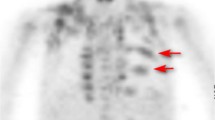Abstract
Brown fat uptake of 2-deoxy-2-[F-18]fluoro-d-glucose (FDG) on a positron emission tomography (PET) scan limits the ability to assess for cancer. Drugs such as benzodiazepine, propranolol, and reserpine have been proposed to reduce this uptake, but the studies have been either small clinical or preclinical trials. As an alternative, we evaluated the effect of controlling the patient’s environmental temperature on brown fat uptake of FDG.
Method
From January 1, 2002 to November 30, 2004, patients were identified who had (1) a pattern of FDG uptake in the neck/paravertebral areas suggestive of brown fat, (2) a repeat FDG-PET scan after control of the patient’s environmental temperature, and (3) no evidence of cancer in the neck/paravertebral areas by other diagnostic methods. For the follow-up PET scan, all patients wore warm clothing and avoided exposure to cold air during their transit to our facility. After arrival, patients were kept in a separate temperature-controlled room (at least 75°F) for 15 minutes to two hours before FDG injection as well as during the uptake phase. Four physicians blindly and retrospectively assessed the FDG uptake in the neck and paravertebral regions on all initial and temperature-controlled PET scans by visually grading the radioactivity on a semiquantitative scale (0 = background, 1+ = background but <liver, 2+ = equal to liver, 3+ >liver). The changes in maximal SUVs were determined in the left and right neck region. Data were evaluated using a two-tail t-test.
Results
Ten patients met the above criteria. The median age was 32 years with a range of 11–58 years. In comparing the semiquantitative uptake and the SUVs of FDG in the neck and paravertebral areas on the initial PET scan to the temperature-controlled PET scan, the mean decrease and the standard deviation of the decrease demonstrated a statistically significant decrease in with P values range from <0.02 to <0.001.
Conclusion
Controlling the patient’s environmental temperature prior to the dosing and during the uptake phase can significantly reduce FDG uptake in brown fat in the neck and paravertebral areas. Further studies are warranted to determine the most effective protocol to control the patient’s environmental temperature in order to minimize brown fat uptake.



Similar content being viewed by others
References
Cohade C, Osman M, Pannu H, Wahl R (2003) Uptake in supraclavicular area fat (“USA-Fat”): Description on 18F-FDG PET/CT. J Nucl Med 44:170–176
Yeung H, Grewal R, Gonen M, Schoder H, Larson S (2003) Patterns of 18F-FDG uptake in adipose tissue and muscle: A potential source of false positives for PET. J Nucl Med 44:1789–1796
Hany TF, Gharehpapagh E, Kamel EM, Buck A, Himms-Hagen J, von Schulthess GK (2002) Brown adipose tissue: A factor to consider in symmetrical tracer uptake in the neck and upper chest region. Eur J Nucl Med Mol Imaging 29:1393–1398
Gordon B, Flanagan F, Dehdashti F (1997) Whole-body positron emission tomography: Normal variations, pitfalls, and technical considerations. AJR 169:1675–1680
Truong MT, Erasmus JJ, Munden RF, Marom EM, Sabloff BS, Gladish GW, Podoloff DA, Macapinlac HA (2004) Focal FDG uptake in mediastinal brown fat mimicking malignancy: A potential pitfall resolved on PET/CT. Am J Roentgenol 183:1127–1132
Minotti AJ, Shah K, Keller K (2004) Positron emission tomography/computed tomography fusion imaging in brown adipose tissue. Clin Nucl Med 29:4–11
Barrington S, Maisey M (1996) Skeletal muscle uptake of Fluorine-18-FDG: Effect of oral diazepam. J Nucl Med 37:1127–1129
Cohade C, Mourtzikos K, Wahl R (2003) “USA-Fat”: Prevalence is related to ambient outdoor temperature—evaluation with 18F-FDG PET/CT. J Nucl Med 44:1267–1270
Garcia CA, Van Nostrand D, Majd M, Atkins F, Acio E, Sheikh A, Butler C (2004) Benzodiazepine-resistant “brown fat” pattern in positron emission tomography: Two case reports of resolution with temperature control. Mol Imaging Biol 6:368–372
Tatsumi M, Engles JM, Ishimori T, Nicely O, Cohade C, Wahl RL (2004) Intense 18F-FDG uptake in brown fat can be reduced pharmacologically. J Nucl Med 45:1189–1193
Wolfgang A, Weber MD (2004) Brown adipose tissue and nuclear medicine imaging. J Nucl Med 45:1101–1103
Author information
Authors and Affiliations
Corresponding author
Rights and permissions
About this article
Cite this article
Garcia, C.A., Van Nostrand, D., Atkins, F. et al. Reduction of Brown Fat 2-Deoxy-2-[F-18]fluoro-d-glucose Uptake by Controlling Environmental Temperature Prior to Positron Emission Tomography Scan. Mol Imaging Biol 8, 24–29 (2006). https://doi.org/10.1007/s11307-005-0030-3
Published:
Issue Date:
DOI: https://doi.org/10.1007/s11307-005-0030-3




